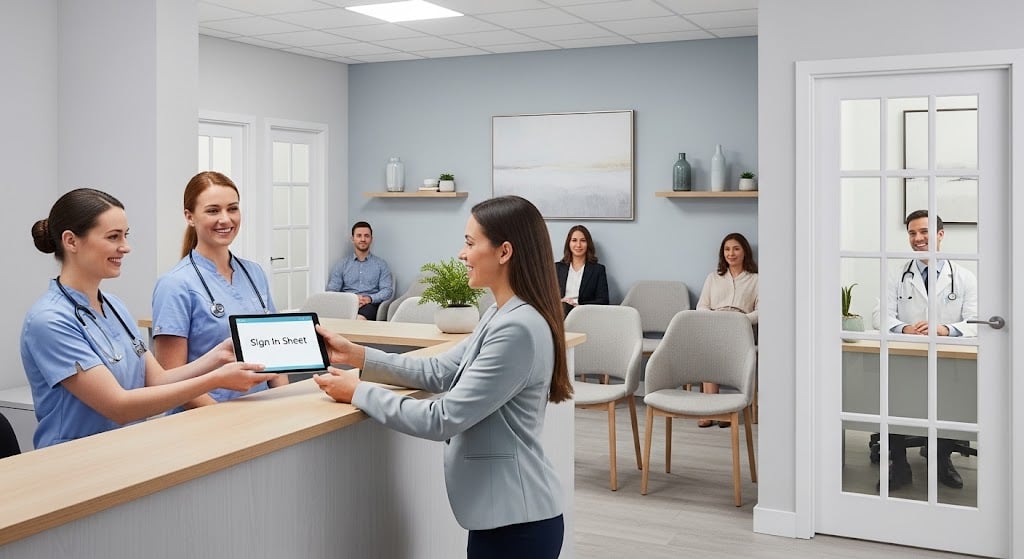Which Part of Your Workflow Needs Integration First?
💡Not every process needs integration on day one. The key is knowing where to begin. By identifying the most painful parts of your...
34 min read
Alvin Amoroso : 6/24/25 11:01 PM

In the complex and demanding world of healthcare, efficiency and accuracy are not just business metrics—they are critical components of patient safety and quality of care. Healthcare workflow automation is the technology-driven process of streamlining, automating, and optimizing the series of tasks that constitute healthcare operations, from patient intake to billing and beyond. It involves using software and intelligent systems to manage and execute repetitive, rule-based tasks, thereby freeing up healthcare professionals to focus on what they do best: providing exceptional patient care. This transformation is crucial for modern healthcare organizations looking to reduce administrative burdens, minimize human error, improve communication, and ultimately deliver better health outcomes in an increasingly complex regulatory and economic environment.
The pressure on healthcare systems worldwide is immense. Rising patient volumes, an aging population, staff shortages, and the ever-present need to control costs create a perfect storm of challenges. Manual processes, which are often slow, prone to error, and siloed, can no longer keep pace. They lead to administrative bloat, physician burnout, and frustrating delays for patients. This is where the strategic implementation of workflow automation in healthcare becomes a game-changer. By intelligently automating key processes, hospitals, clinics, and care facilities can create a more resilient, responsive, and patient-centric operational model.
This guide will provide an exhaustive look into the world of healthcare workflow automation. We will explore its core concepts, unpack its extensive benefits, and provide a step-by-step implementation plan. Most importantly, we will detail 35 specific, real-world examples of how automation is revolutionizing patient care and operational efficiency across administrative, clinical, and back-office functions. From initial appointment scheduling to complex clinical trial management, you will discover how this powerful technology is reshaping the future of healthcare delivery for the better.
Before diving into the myriad applications of this technology, it's essential to build a strong foundational understanding of what we mean by "workflow automation" in a healthcare context. This isn't simply about digitizing a paper form; it's about re-engineering entire processes for maximum efficiency, safety, and intelligence. By grasping these core concepts, you can better appreciate the transformative potential of clinical workflow automation and its related technologies.
At its heart, workflow automation in healthcare refers to the design, execution, and automation of processes based on predefined rules where tasks, information, or documents are passed from one participant to another for action. Think of it as a digital nervous system for a healthcare organization. Instead of relying on manual handoffs—like a nurse walking a paper chart to a physician or a billing clerk manually entering data from a form—the automation platform manages the flow of work.
This technology uses software to connect disparate systems (like an Electronic Health Record (EHR), a Laboratory Information System (LIS), and a billing platform), trigger actions based on specific events (like a new lab result arriving), and route tasks to the appropriate person or system. The goal is to ensure that every process is executed consistently, efficiently, and with a complete, auditable trail. This systematic approach is fundamental to creating a more reliable and less chaotic healthcare environment, directly addressing a core challenge in modern medicine.
While often used interchangeably with workflow automation, "process automation in healthcare" is a slightly broader term. Process automation can refer to the automation of any business process, which might include single, discrete tasks. For example, using a bot to scrape data from a website and enter it into a spreadsheet is a form of process automation.
Healthcare workflow automation is a more specific and sophisticated subset of process automation. It is concerned with orchestrating a sequence of tasks that involve multiple steps and often multiple people or systems. A workflow has a defined beginning and end and a clear business logic that governs its path.
Essentially, workflow automation manages the entire journey, while process automation might handle just one stop along the way.
When automation is applied directly to patient care activities, it is often referred to as clinical workflow automation. This is where the technology has its most profound impact on patient safety and outcomes. Clinical environments are dynamic and high-stakes, and manual processes can introduce dangerous variables.
Consider medication administration. A manual workflow might involve a physician writing a prescription, a nurse transcribing it, a pharmacist filling it, and another nurse administering it. Each step is a potential point of failure due to illegible handwriting, transcription errors, or miscommunication.
Clinical workflow automation transforms this process. A physician enters the order into a Computerized Physician Order Entry (CPOE) system. The order is digitally transmitted to the pharmacy, where it is verified against the patient's record for allergies or interactions. The system then updates the electronic Medication Administration Record (eMAR), and a nurse uses a barcode scanner to confirm the right patient, right drug, and right dose before administration. This automated, closed-loop workflow dramatically reduces the risk of medication errors, showcasing the vital role of automation in enhancing patient safety.
Healthcare workflow automation is powered by a combination of technologies working in concert. The central component is typically a workflow management system or a Business Process Management (BPM) suite tailored for healthcare. These platforms provide the tools to design, execute, and monitor workflows.
Key underlying technologies include:
Together, these technologies create a powerful toolkit that allows healthcare organizations to automate not just simple tasks, but complex, multi-step processes that are central to their operations.
The decision to invest in and implement workflow automation for healthcare is driven by a compelling range of benefits that impact nearly every facet of an organization. These advantages go far beyond simple cost-cutting, extending to improved quality of care, enhanced patient and staff satisfaction, and stronger regulatory compliance. By automating processes, healthcare providers can build a more resilient and efficient operational foundation, allowing them to thrive in a challenging landscape.
This is often the most immediate and measurable benefit. Manual, repetitive tasks consume a significant portion of a healthcare professional's day. From administrative staff handling paperwork to nurses transcribing notes, these activities are slow and divert time from higher-value work. Healthcare workflow automation takes over these burdensome tasks. For example, automating the patient registration process can reduce check-in times from minutes to seconds. Automating claims processing allows billing staff to manage a higher volume of claims with greater accuracy. This massive boost in productivity means existing staff can handle more work, and highly-trained clinical professionals can dedicate more of their time to direct patient interaction, diagnosis, and treatment planning.
Human error is an unavoidable consequence of manual data entry and repetitive tasks. In a healthcare setting, these errors can have serious consequences. A mistyped insurance ID can lead to a denied claim and a frustrating billing cycle. A transcribed medication dosage error can lead to a severe adverse drug event. Workflow automation in healthcare minimizes these risks by removing the manual "middleman." When data flows directly from one system to another—from the EHR to the billing system, for instance—the opportunity for transcription errors is eliminated. By standardizing processes and enforcing predefined rules, automation ensures that tasks are performed correctly and consistently every time, leading to higher data quality and fewer costly mistakes.
This is arguably the most critical benefit of clinical workflow automation. Automated systems can build safety checks and balances directly into the care delivery process. Consider a system that automatically cross-references a new medication order with a patient's known allergies in their EHR and flags a potential conflict before the prescription is even sent to the pharmacy. Or an automated workflow that notifies a care team when a patient's vital signs from a remote monitoring device fall outside a safe range. These automated alerts and verifications create a digital safety net that supports clinical decision-making and helps prevent harm. By ensuring timely communication of critical lab results and streamlining handoffs between departments, automation directly contributes to better, safer patient care.
While there is an upfront investment, the return on investment (ROI) for healthcare automation is substantial. Cost savings come from several areas. Firstly, increased efficiency means fewer staff hours are needed for administrative tasks, reducing labor costs or allowing for reallocation of staff to patient-facing roles. Secondly, reducing errors in billing and coding leads to fewer claim denials, faster reimbursement cycles, and improved revenue capture. Thirdly, better inventory management through automation reduces waste and prevents shortages of critical supplies. By optimizing staff schedules and resource utilization based on real-time patient flow data, automation ensures that expensive resources—from operating rooms to specialized staff—are used to their fullest potential.
Clinician burnout is a critical crisis in the healthcare industry, driven largely by overwhelming administrative burdens. Physicians and nurses often spend hours each day on documentation, paperwork, and navigating clunky software systems, which leads to frustration and detracts from the rewarding aspects of their jobs. Workflow automation for healthcare directly addresses this pain point. By automating the most tedious parts of their day, it allows clinicians to practice at the top of their license. This not only improves their job satisfaction but also aids in staff retention, which is a major challenge and expense for healthcare organizations. A happier, more engaged workforce is better equipped to provide compassionate and effective patient care.
Fragmented communication is a notorious problem in healthcare. A patient's journey often involves multiple departments and specialists, and critical information can get lost in manual handoffs via phone calls, pagers, or faxes. Automation creates clear, efficient, and auditable communication channels. For example, an automated referral management workflow ensures that when a primary care physician refers a patient to a specialist, all necessary records and documentation are transferred instantly and securely. The system can track the referral's status, notify both parties of the scheduled appointment, and ensure the consulting physician's notes are sent back to the PCP. This seamless flow of information ensures better care coordination and a more cohesive patient experience.
The healthcare industry is governed by strict regulations, most notably the Health Insurance Portability and Accountability Act (HIPAA), which mandates the security and privacy of protected health information (PHI). Manual processes create significant compliance risks, as paper documents can be misplaced and unsecured emails can be breached. Automation platforms designed for healthcare are built with compliance in mind. They provide secure, role-based access to information, ensuring that only authorized individuals can view PHI. Furthermore, every action within an automated workflow is logged, creating a detailed and immutable audit trail. This makes it simple to demonstrate compliance during an audit and to investigate any potential incidents, providing a level of security and accountability that manual processes cannot match.
The true power of healthcare workflow automation is best understood through its practical applications. The following 35 examples are categorized to illustrate how automation can be deployed across the entire spectrum of healthcare operations—from the front desk to the operating room to the back office. Each example represents a significant opportunity to enhance efficiency, reduce costs, and improve patient care.
This category focuses on the administrative processes that define the patient's journey, from their first interaction with the provider to post-discharge follow-up. Automating these workflows is key to creating a positive patient experience and reducing the administrative burden on front-office staff.

This category delves into the core of patient care: the diagnostic and treatment processes. Clinical workflow automation in these areas is paramount for enhancing patient safety, improving diagnostic accuracy, and ensuring timely interventions.
This category covers the essential but often invisible administrative and operational tasks that keep a healthcare facility running. Automating these back-office functions is crucial for financial health, staff management, and regulatory compliance.
This final category highlights more advanced and innovative applications of workflow automation, often leveraging AI and predictive analytics. These examples showcase the future of workflow automation in healthcare and provide unique value that competitors may not be considering.
Successfully implementing healthcare workflow automation is a strategic initiative that requires careful planning, stakeholder buy-in, and a phased approach. It's not just about purchasing software; it's about fundamentally re-engineering processes. Following a structured implementation plan can ensure a smoother transition and maximize the return on investment.
The first step is to identify which processes are the best candidates for automation. Not all workflows are created equal.
The market for workflow automation for healthcare is vast. Selecting the right platform is critical.
With a platform selected, it's time to design the new, automated process.
This is often the most technical and challenging phase.
Technology is only half the battle. People and processes are the other half.
Implementation is not the end of the project; it's the beginning of a cycle of continuous improvement.
While the benefits are immense, the path to implementing clinical workflow automation is not without its obstacles. Being aware of these common challenges allows organizations to plan proactively and develop strategies to mitigate them, ensuring a more successful and sustainable automation program.
The field of workflow automation in healthcare is not static. It is continually evolving, driven by rapid advancements in artificial intelligence and data analytics. The workflows of today are just the beginning. Looking ahead, several key trends are poised to make automation even more intelligent, pervasive, and impactful.
The future lies in "hyperautomation," a concept that involves combining multiple advanced technologies—including AI, machine learning, and RPA—to automate and augment an ever-wider range of business and clinical processes. Instead of just automating discrete tasks, hyperautomation aims to create a truly intelligent and adaptive operational fabric. In this paradigm, AI will not just follow predefined rules but will learn from data to optimize workflows in real-time. For example, an AI-powered scheduling system won't just offer open slots; it will predict the likelihood of a no-show for each patient and double-book slots accordingly to maximize schedule utilization.
Future clinical workflow automation will be deeply integrated with predictive analytics. By analyzing historical and real-time patient data, these systems will be able to predict risks and trigger preventative workflows. Imagine a system that analyzes a patient's EHR data and predicts they are at high risk for developing sepsis. This prediction could automatically trigger a workflow that places specific lab orders, alerts the nursing staff to perform more frequent vital sign checks, and provides the physician with a "sepsis risk score" and evidence-based treatment protocols. This shifts care from being reactive to being proactive and predictive.
While APIs are the preferred method for integration, RPA will continue to play a crucial role as the "glue" that connects modern automation platforms to the long tail of legacy systems and external websites (like payer portals) that are a reality in healthcare. As RPA bots become more intelligent—infused with AI capabilities for reading unstructured documents and understanding context—they will be able to handle even more complex tasks, further extending the reach of automation into every corner of the healthcare ecosystem. The synergy between sophisticated workflow orchestration platforms and intelligent RPA bots will be a defining feature of the next generation of healthcare automation.
Workflow automation in healthcare is the use of technology and software to streamline and manage the series of tasks that make up healthcare processes. It automatically routes information, triggers actions based on predefined rules, and connects different IT systems (like EHRs and billing software) to reduce manual work, minimize errors, and improve efficiency. Its primary goal is to free up clinicians and staff to focus on patient care.
There are countless examples across healthcare. A few diverse ones include:
Process automation is a broad term for using technology to perform any single or multi-step business process. Healthcare workflow automation is a specific type of process automation focused on orchestrating a sequence of tasks that often involve multiple people and systems to complete a larger objective, such as the entire patient discharge process from start to finish.
The imperative for change in the healthcare industry has never been stronger. Faced with mounting pressures from all sides, organizations can no longer afford the inefficiencies, risks, and costs inherent in manual, paper-based processes. Healthcare workflow automation is not a futuristic luxury; it is a foundational technology for survival and success in the 21st century.
As we have seen through 35 distinct examples, the applications of this technology are both broad and deep, touching every aspect of the healthcare journey. From creating a seamless, consumer-friendly patient experience to fortifying patient safety with clinical workflow automation, and from strengthening the organization's financial health to reducing the crippling administrative burden on our vital clinicians, the benefits are clear, compelling, and cumulative.
Implementing workflow automation in healthcare is a strategic commitment to building a more efficient, resilient, and intelligent organization. It is about creating an environment where technology handles the repetitive and rule-based, freeing human professionals to handle the complex and compassionate. By embracing automation, healthcare leaders can pave the way for a future defined by operational excellence, superior patient outcomes, and a more sustainable model of care delivery.
.png)
💡Not every process needs integration on day one. The key is knowing where to begin. By identifying the most painful parts of your...

Running a small clinic is centered around quality care for each and every patient. But what looks easy from the outside, is in reality juggling a...

💡What are workflow bottlenecks in clinics?In disconnected systems, small handoff failures pile up and become huge delays. Manual re-entry, phone...